HND Business Research: Talent Management Impact on HR at Zara
VerifiedAdded on 2023/06/18
|22
|5152
|427
Report
AI Summary
This research project investigates the impact of talent management on the roles played by human resource managers, focusing on a case study of Zara. It aims to understand the meaning of talent management and human resources in a business context, determine the impact of talent management strategies (such as training, rewards, and employee engagement) on HR roles, and examine the benefits of having talent management and human resources for Zara, including enhanced employee motivation, productivity, and retention. The study employs a positivism research philosophy and an inductive approach, using quantitative research methods, specifically a questionnaire survey, and literature review to gather both primary and secondary data. Findings from the survey, involving 30 Zara employees, are presented through graphs and tables, analyzing the roles played by HR managers, employee satisfaction with talent management strategies, and the impact of these strategies on employee retention and productivity. The research concludes with recommendations for improving talent management practices within Zara to further enhance employee engagement and reduce turnover.
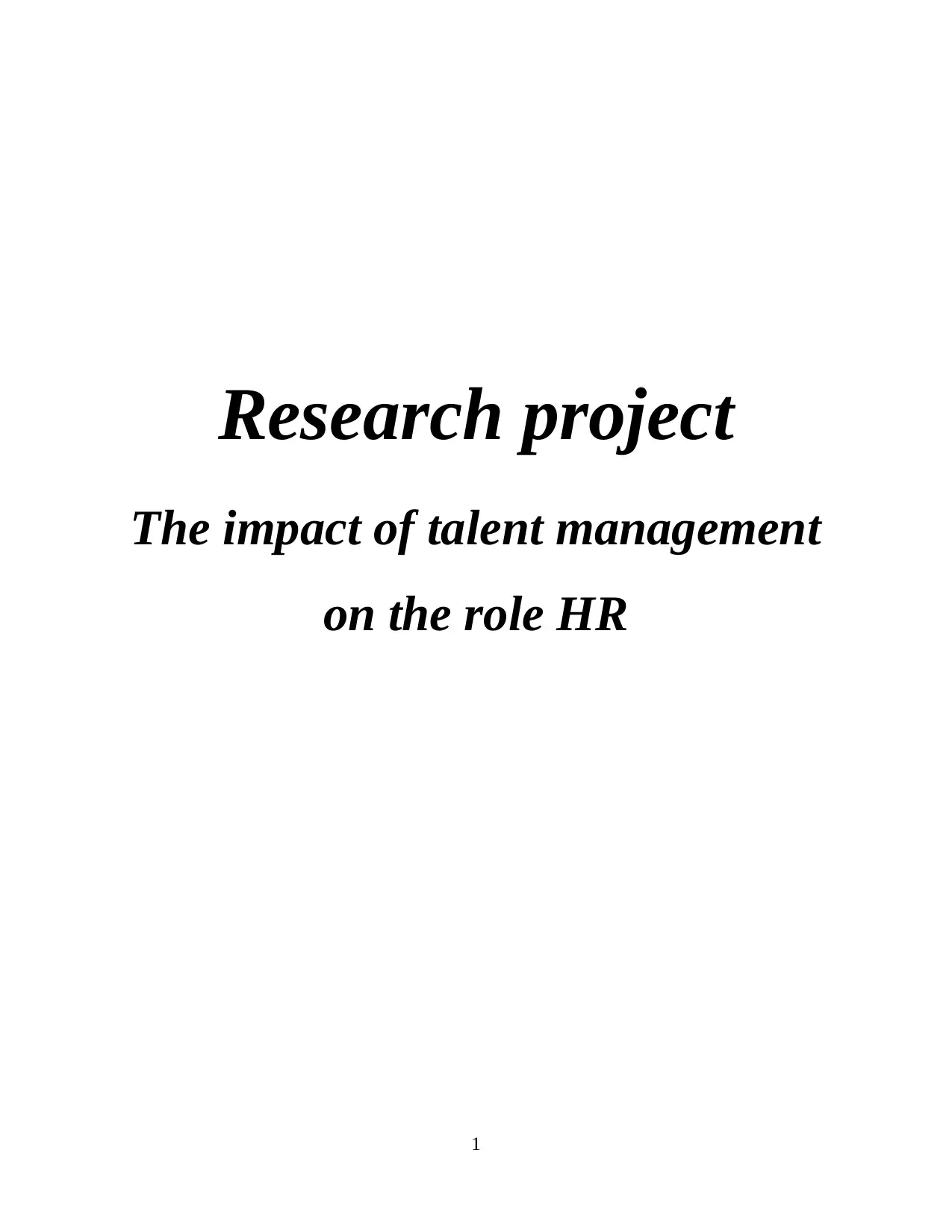
Research project
The impact of talent management
on the role HR
1
The impact of talent management
on the role HR
1
Paraphrase This Document
Need a fresh take? Get an instant paraphrase of this document with our AI Paraphraser
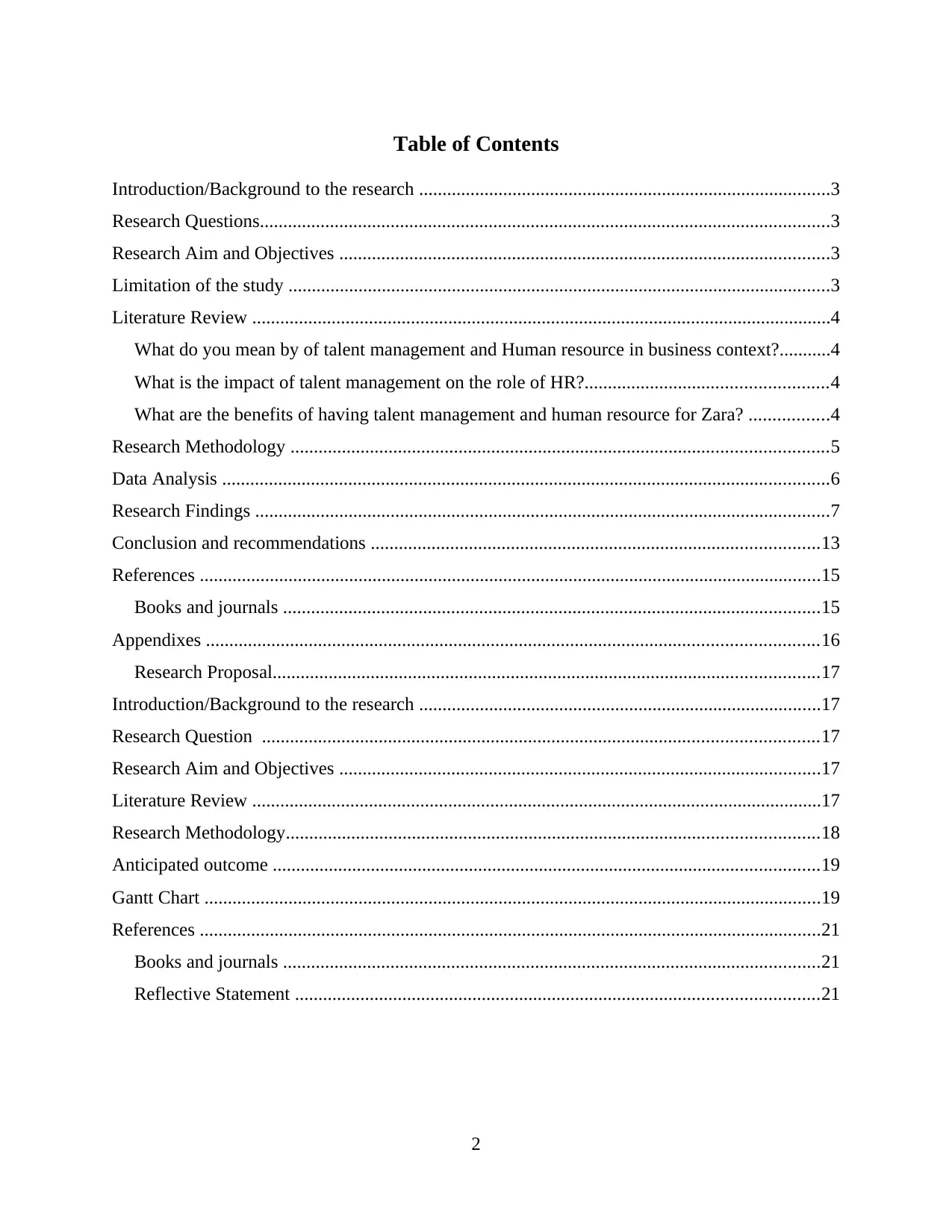
Table of Contents
Introduction/Background to the research ........................................................................................3
Research Questions..........................................................................................................................3
Research Aim and Objectives .........................................................................................................3
Limitation of the study ....................................................................................................................3
Literature Review ............................................................................................................................4
What do you mean by of talent management and Human resource in business context?...........4
What is the impact of talent management on the role of HR?....................................................4
What are the benefits of having talent management and human resource for Zara? .................4
Research Methodology ...................................................................................................................5
Data Analysis ..................................................................................................................................6
Research Findings ...........................................................................................................................7
Conclusion and recommendations ................................................................................................13
References .....................................................................................................................................15
Books and journals ...................................................................................................................15
Appendixes ...................................................................................................................................16
Research Proposal.....................................................................................................................17
Introduction/Background to the research ......................................................................................17
Research Question .......................................................................................................................17
Research Aim and Objectives .......................................................................................................17
Literature Review ..........................................................................................................................17
Research Methodology..................................................................................................................18
Anticipated outcome .....................................................................................................................19
Gantt Chart ....................................................................................................................................19
References .....................................................................................................................................21
Books and journals ...................................................................................................................21
Reflective Statement ................................................................................................................21
2
Introduction/Background to the research ........................................................................................3
Research Questions..........................................................................................................................3
Research Aim and Objectives .........................................................................................................3
Limitation of the study ....................................................................................................................3
Literature Review ............................................................................................................................4
What do you mean by of talent management and Human resource in business context?...........4
What is the impact of talent management on the role of HR?....................................................4
What are the benefits of having talent management and human resource for Zara? .................4
Research Methodology ...................................................................................................................5
Data Analysis ..................................................................................................................................6
Research Findings ...........................................................................................................................7
Conclusion and recommendations ................................................................................................13
References .....................................................................................................................................15
Books and journals ...................................................................................................................15
Appendixes ...................................................................................................................................16
Research Proposal.....................................................................................................................17
Introduction/Background to the research ......................................................................................17
Research Question .......................................................................................................................17
Research Aim and Objectives .......................................................................................................17
Literature Review ..........................................................................................................................17
Research Methodology..................................................................................................................18
Anticipated outcome .....................................................................................................................19
Gantt Chart ....................................................................................................................................19
References .....................................................................................................................................21
Books and journals ...................................................................................................................21
Reflective Statement ................................................................................................................21
2
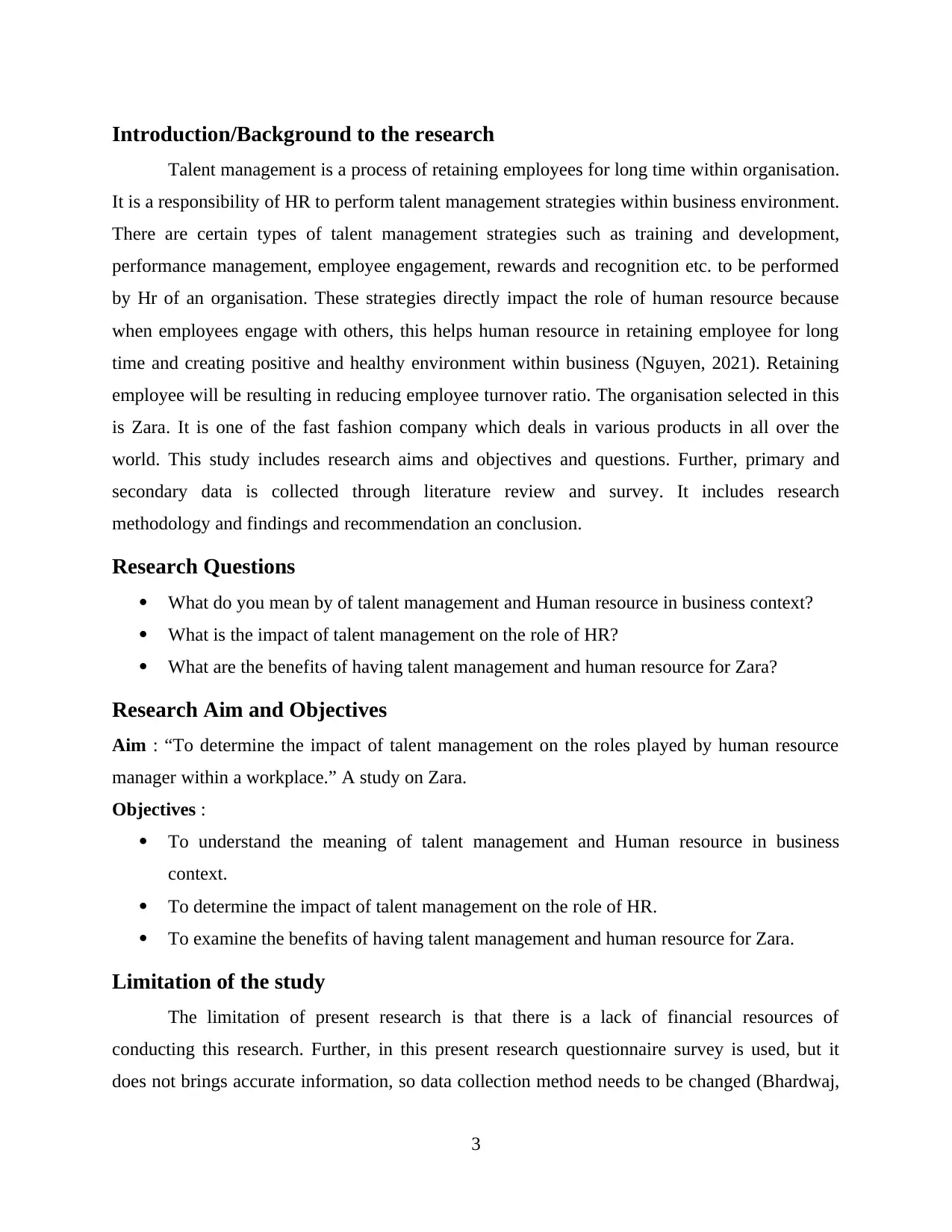
Introduction/Background to the research
Talent management is a process of retaining employees for long time within organisation.
It is a responsibility of HR to perform talent management strategies within business environment.
There are certain types of talent management strategies such as training and development,
performance management, employee engagement, rewards and recognition etc. to be performed
by Hr of an organisation. These strategies directly impact the role of human resource because
when employees engage with others, this helps human resource in retaining employee for long
time and creating positive and healthy environment within business (Nguyen, 2021). Retaining
employee will be resulting in reducing employee turnover ratio. The organisation selected in this
is Zara. It is one of the fast fashion company which deals in various products in all over the
world. This study includes research aims and objectives and questions. Further, primary and
secondary data is collected through literature review and survey. It includes research
methodology and findings and recommendation an conclusion.
Research Questions
What do you mean by of talent management and Human resource in business context?
What is the impact of talent management on the role of HR?
What are the benefits of having talent management and human resource for Zara?
Research Aim and Objectives
Aim : “To determine the impact of talent management on the roles played by human resource
manager within a workplace.” A study on Zara.
Objectives :
To understand the meaning of talent management and Human resource in business
context.
To determine the impact of talent management on the role of HR.
To examine the benefits of having talent management and human resource for Zara.
Limitation of the study
The limitation of present research is that there is a lack of financial resources of
conducting this research. Further, in this present research questionnaire survey is used, but it
does not brings accurate information, so data collection method needs to be changed (Bhardwaj,
3
Talent management is a process of retaining employees for long time within organisation.
It is a responsibility of HR to perform talent management strategies within business environment.
There are certain types of talent management strategies such as training and development,
performance management, employee engagement, rewards and recognition etc. to be performed
by Hr of an organisation. These strategies directly impact the role of human resource because
when employees engage with others, this helps human resource in retaining employee for long
time and creating positive and healthy environment within business (Nguyen, 2021). Retaining
employee will be resulting in reducing employee turnover ratio. The organisation selected in this
is Zara. It is one of the fast fashion company which deals in various products in all over the
world. This study includes research aims and objectives and questions. Further, primary and
secondary data is collected through literature review and survey. It includes research
methodology and findings and recommendation an conclusion.
Research Questions
What do you mean by of talent management and Human resource in business context?
What is the impact of talent management on the role of HR?
What are the benefits of having talent management and human resource for Zara?
Research Aim and Objectives
Aim : “To determine the impact of talent management on the roles played by human resource
manager within a workplace.” A study on Zara.
Objectives :
To understand the meaning of talent management and Human resource in business
context.
To determine the impact of talent management on the role of HR.
To examine the benefits of having talent management and human resource for Zara.
Limitation of the study
The limitation of present research is that there is a lack of financial resources of
conducting this research. Further, in this present research questionnaire survey is used, but it
does not brings accurate information, so data collection method needs to be changed (Bhardwaj,
3
⊘ This is a preview!⊘
Do you want full access?
Subscribe today to unlock all pages.

Trusted by 1+ million students worldwide
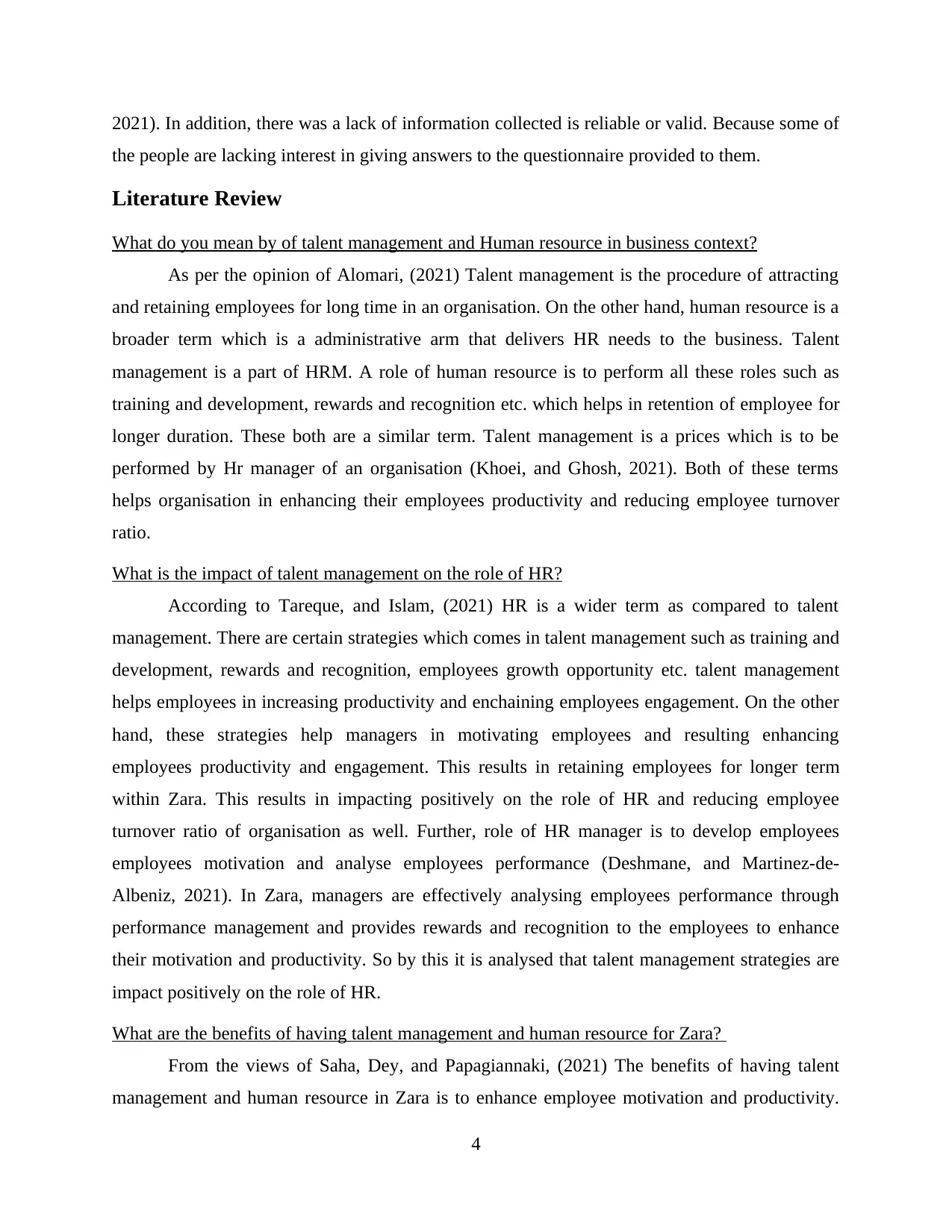
2021). In addition, there was a lack of information collected is reliable or valid. Because some of
the people are lacking interest in giving answers to the questionnaire provided to them.
Literature Review
What do you mean by of talent management and Human resource in business context?
As per the opinion of Alomari, (2021) Talent management is the procedure of attracting
and retaining employees for long time in an organisation. On the other hand, human resource is a
broader term which is a administrative arm that delivers HR needs to the business. Talent
management is a part of HRM. A role of human resource is to perform all these roles such as
training and development, rewards and recognition etc. which helps in retention of employee for
longer duration. These both are a similar term. Talent management is a prices which is to be
performed by Hr manager of an organisation (Khoei, and Ghosh, 2021). Both of these terms
helps organisation in enhancing their employees productivity and reducing employee turnover
ratio.
What is the impact of talent management on the role of HR?
According to Tareque, and Islam, (2021) HR is a wider term as compared to talent
management. There are certain strategies which comes in talent management such as training and
development, rewards and recognition, employees growth opportunity etc. talent management
helps employees in increasing productivity and enchaining employees engagement. On the other
hand, these strategies help managers in motivating employees and resulting enhancing
employees productivity and engagement. This results in retaining employees for longer term
within Zara. This results in impacting positively on the role of HR and reducing employee
turnover ratio of organisation as well. Further, role of HR manager is to develop employees
employees motivation and analyse employees performance (Deshmane, and Martinez-de-
Albeniz, 2021). In Zara, managers are effectively analysing employees performance through
performance management and provides rewards and recognition to the employees to enhance
their motivation and productivity. So by this it is analysed that talent management strategies are
impact positively on the role of HR.
What are the benefits of having talent management and human resource for Zara?
From the views of Saha, Dey, and Papagiannaki, (2021) The benefits of having talent
management and human resource in Zara is to enhance employee motivation and productivity.
4
the people are lacking interest in giving answers to the questionnaire provided to them.
Literature Review
What do you mean by of talent management and Human resource in business context?
As per the opinion of Alomari, (2021) Talent management is the procedure of attracting
and retaining employees for long time in an organisation. On the other hand, human resource is a
broader term which is a administrative arm that delivers HR needs to the business. Talent
management is a part of HRM. A role of human resource is to perform all these roles such as
training and development, rewards and recognition etc. which helps in retention of employee for
longer duration. These both are a similar term. Talent management is a prices which is to be
performed by Hr manager of an organisation (Khoei, and Ghosh, 2021). Both of these terms
helps organisation in enhancing their employees productivity and reducing employee turnover
ratio.
What is the impact of talent management on the role of HR?
According to Tareque, and Islam, (2021) HR is a wider term as compared to talent
management. There are certain strategies which comes in talent management such as training and
development, rewards and recognition, employees growth opportunity etc. talent management
helps employees in increasing productivity and enchaining employees engagement. On the other
hand, these strategies help managers in motivating employees and resulting enhancing
employees productivity and engagement. This results in retaining employees for longer term
within Zara. This results in impacting positively on the role of HR and reducing employee
turnover ratio of organisation as well. Further, role of HR manager is to develop employees
employees motivation and analyse employees performance (Deshmane, and Martinez-de-
Albeniz, 2021). In Zara, managers are effectively analysing employees performance through
performance management and provides rewards and recognition to the employees to enhance
their motivation and productivity. So by this it is analysed that talent management strategies are
impact positively on the role of HR.
What are the benefits of having talent management and human resource for Zara?
From the views of Saha, Dey, and Papagiannaki, (2021) The benefits of having talent
management and human resource in Zara is to enhance employee motivation and productivity.
4
Paraphrase This Document
Need a fresh take? Get an instant paraphrase of this document with our AI Paraphraser
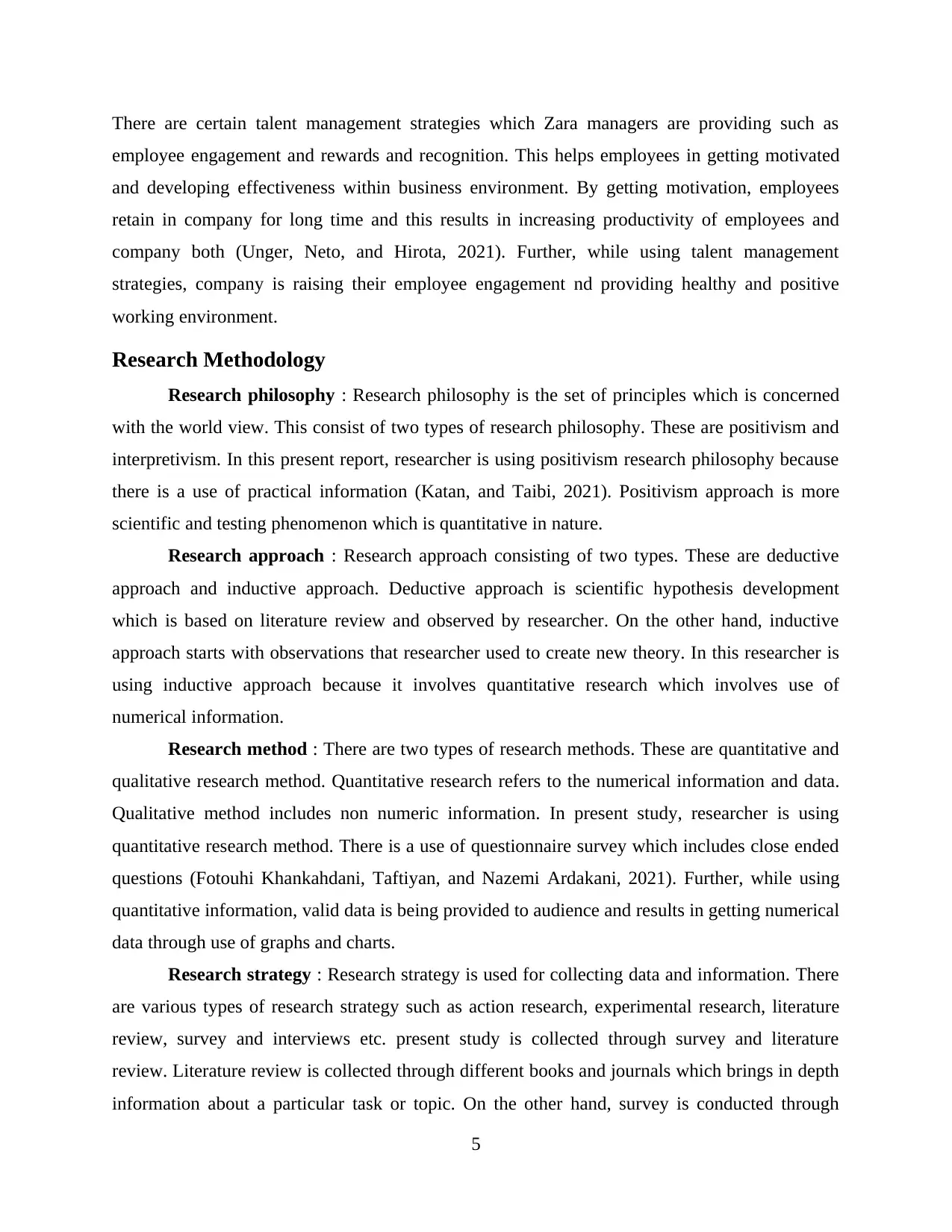
There are certain talent management strategies which Zara managers are providing such as
employee engagement and rewards and recognition. This helps employees in getting motivated
and developing effectiveness within business environment. By getting motivation, employees
retain in company for long time and this results in increasing productivity of employees and
company both (Unger, Neto, and Hirota, 2021). Further, while using talent management
strategies, company is raising their employee engagement nd providing healthy and positive
working environment.
Research Methodology
Research philosophy : Research philosophy is the set of principles which is concerned
with the world view. This consist of two types of research philosophy. These are positivism and
interpretivism. In this present report, researcher is using positivism research philosophy because
there is a use of practical information (Katan, and Taibi, 2021). Positivism approach is more
scientific and testing phenomenon which is quantitative in nature.
Research approach : Research approach consisting of two types. These are deductive
approach and inductive approach. Deductive approach is scientific hypothesis development
which is based on literature review and observed by researcher. On the other hand, inductive
approach starts with observations that researcher used to create new theory. In this researcher is
using inductive approach because it involves quantitative research which involves use of
numerical information.
Research method : There are two types of research methods. These are quantitative and
qualitative research method. Quantitative research refers to the numerical information and data.
Qualitative method includes non numeric information. In present study, researcher is using
quantitative research method. There is a use of questionnaire survey which includes close ended
questions (Fotouhi Khankahdani, Taftiyan, and Nazemi Ardakani, 2021). Further, while using
quantitative information, valid data is being provided to audience and results in getting numerical
data through use of graphs and charts.
Research strategy : Research strategy is used for collecting data and information. There
are various types of research strategy such as action research, experimental research, literature
review, survey and interviews etc. present study is collected through survey and literature
review. Literature review is collected through different books and journals which brings in depth
information about a particular task or topic. On the other hand, survey is conducted through
5
employee engagement and rewards and recognition. This helps employees in getting motivated
and developing effectiveness within business environment. By getting motivation, employees
retain in company for long time and this results in increasing productivity of employees and
company both (Unger, Neto, and Hirota, 2021). Further, while using talent management
strategies, company is raising their employee engagement nd providing healthy and positive
working environment.
Research Methodology
Research philosophy : Research philosophy is the set of principles which is concerned
with the world view. This consist of two types of research philosophy. These are positivism and
interpretivism. In this present report, researcher is using positivism research philosophy because
there is a use of practical information (Katan, and Taibi, 2021). Positivism approach is more
scientific and testing phenomenon which is quantitative in nature.
Research approach : Research approach consisting of two types. These are deductive
approach and inductive approach. Deductive approach is scientific hypothesis development
which is based on literature review and observed by researcher. On the other hand, inductive
approach starts with observations that researcher used to create new theory. In this researcher is
using inductive approach because it involves quantitative research which involves use of
numerical information.
Research method : There are two types of research methods. These are quantitative and
qualitative research method. Quantitative research refers to the numerical information and data.
Qualitative method includes non numeric information. In present study, researcher is using
quantitative research method. There is a use of questionnaire survey which includes close ended
questions (Fotouhi Khankahdani, Taftiyan, and Nazemi Ardakani, 2021). Further, while using
quantitative information, valid data is being provided to audience and results in getting numerical
data through use of graphs and charts.
Research strategy : Research strategy is used for collecting data and information. There
are various types of research strategy such as action research, experimental research, literature
review, survey and interviews etc. present study is collected through survey and literature
review. Literature review is collected through different books and journals which brings in depth
information about a particular task or topic. On the other hand, survey is conducted through
5
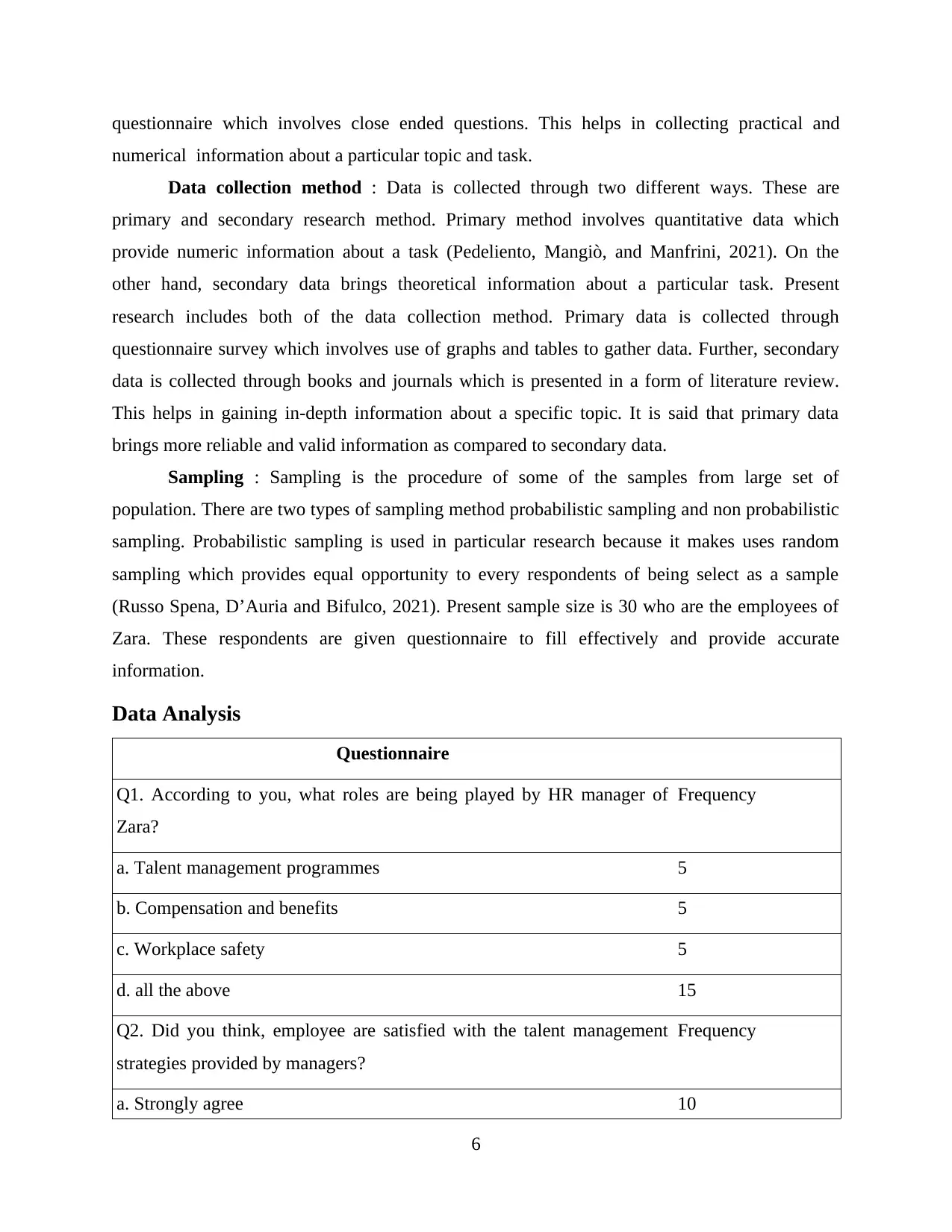
questionnaire which involves close ended questions. This helps in collecting practical and
numerical information about a particular topic and task.
Data collection method : Data is collected through two different ways. These are
primary and secondary research method. Primary method involves quantitative data which
provide numeric information about a task (Pedeliento, Mangiò, and Manfrini, 2021). On the
other hand, secondary data brings theoretical information about a particular task. Present
research includes both of the data collection method. Primary data is collected through
questionnaire survey which involves use of graphs and tables to gather data. Further, secondary
data is collected through books and journals which is presented in a form of literature review.
This helps in gaining in-depth information about a specific topic. It is said that primary data
brings more reliable and valid information as compared to secondary data.
Sampling : Sampling is the procedure of some of the samples from large set of
population. There are two types of sampling method probabilistic sampling and non probabilistic
sampling. Probabilistic sampling is used in particular research because it makes uses random
sampling which provides equal opportunity to every respondents of being select as a sample
(Russo Spena, D’Auria and Bifulco, 2021). Present sample size is 30 who are the employees of
Zara. These respondents are given questionnaire to fill effectively and provide accurate
information.
Data Analysis
Questionnaire
Q1. According to you, what roles are being played by HR manager of
Zara?
Frequency
a. Talent management programmes 5
b. Compensation and benefits 5
c. Workplace safety 5
d. all the above 15
Q2. Did you think, employee are satisfied with the talent management
strategies provided by managers?
Frequency
a. Strongly agree 10
6
numerical information about a particular topic and task.
Data collection method : Data is collected through two different ways. These are
primary and secondary research method. Primary method involves quantitative data which
provide numeric information about a task (Pedeliento, Mangiò, and Manfrini, 2021). On the
other hand, secondary data brings theoretical information about a particular task. Present
research includes both of the data collection method. Primary data is collected through
questionnaire survey which involves use of graphs and tables to gather data. Further, secondary
data is collected through books and journals which is presented in a form of literature review.
This helps in gaining in-depth information about a specific topic. It is said that primary data
brings more reliable and valid information as compared to secondary data.
Sampling : Sampling is the procedure of some of the samples from large set of
population. There are two types of sampling method probabilistic sampling and non probabilistic
sampling. Probabilistic sampling is used in particular research because it makes uses random
sampling which provides equal opportunity to every respondents of being select as a sample
(Russo Spena, D’Auria and Bifulco, 2021). Present sample size is 30 who are the employees of
Zara. These respondents are given questionnaire to fill effectively and provide accurate
information.
Data Analysis
Questionnaire
Q1. According to you, what roles are being played by HR manager of
Zara?
Frequency
a. Talent management programmes 5
b. Compensation and benefits 5
c. Workplace safety 5
d. all the above 15
Q2. Did you think, employee are satisfied with the talent management
strategies provided by managers?
Frequency
a. Strongly agree 10
6
⊘ This is a preview!⊘
Do you want full access?
Subscribe today to unlock all pages.

Trusted by 1+ million students worldwide
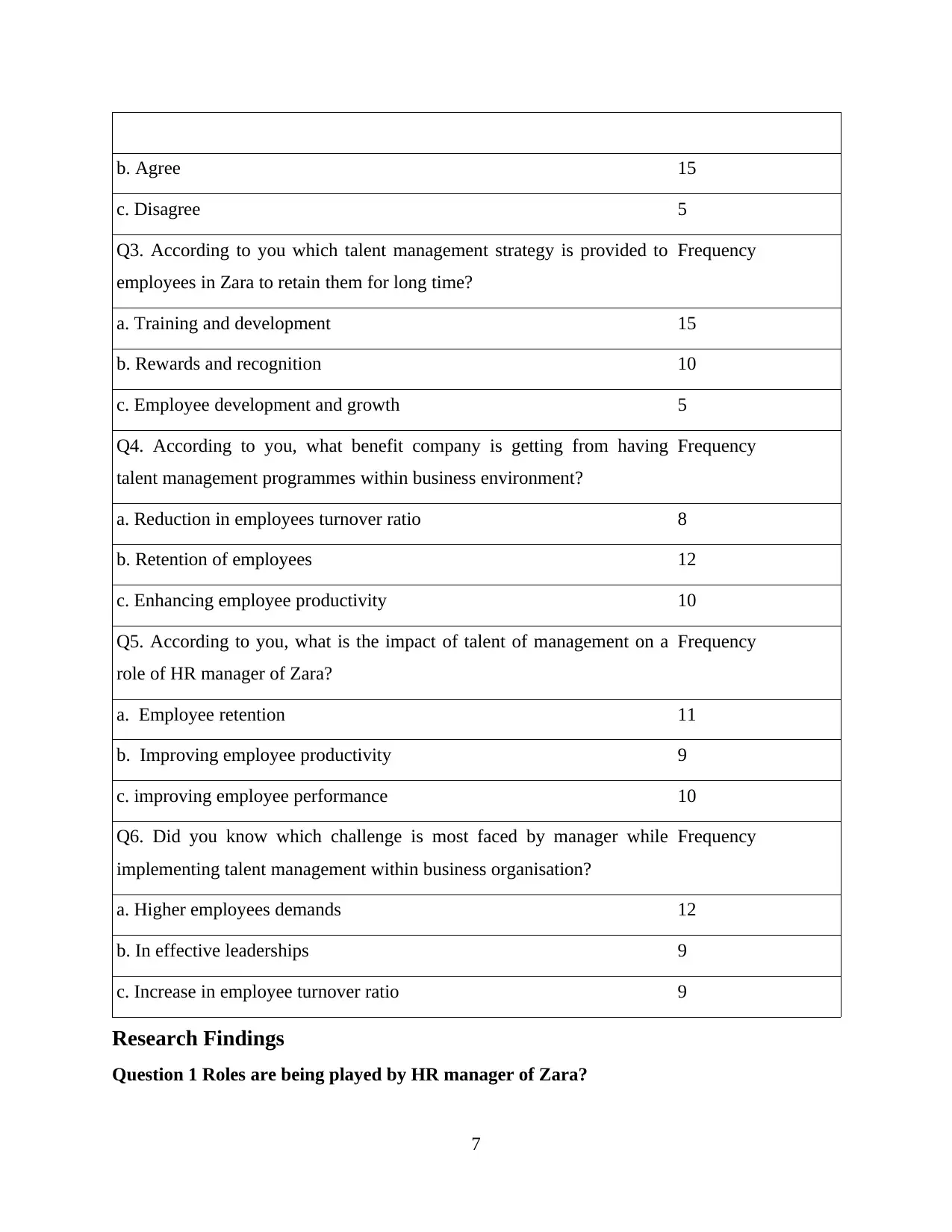
b. Agree 15
c. Disagree 5
Q3. According to you which talent management strategy is provided to
employees in Zara to retain them for long time?
Frequency
a. Training and development 15
b. Rewards and recognition 10
c. Employee development and growth 5
Q4. According to you, what benefit company is getting from having
talent management programmes within business environment?
Frequency
a. Reduction in employees turnover ratio 8
b. Retention of employees 12
c. Enhancing employee productivity 10
Q5. According to you, what is the impact of talent of management on a
role of HR manager of Zara?
Frequency
a. Employee retention 11
b. Improving employee productivity 9
c. improving employee performance 10
Q6. Did you know which challenge is most faced by manager while
implementing talent management within business organisation?
Frequency
a. Higher employees demands 12
b. In effective leaderships 9
c. Increase in employee turnover ratio 9
Research Findings
Question 1 Roles are being played by HR manager of Zara?
7
c. Disagree 5
Q3. According to you which talent management strategy is provided to
employees in Zara to retain them for long time?
Frequency
a. Training and development 15
b. Rewards and recognition 10
c. Employee development and growth 5
Q4. According to you, what benefit company is getting from having
talent management programmes within business environment?
Frequency
a. Reduction in employees turnover ratio 8
b. Retention of employees 12
c. Enhancing employee productivity 10
Q5. According to you, what is the impact of talent of management on a
role of HR manager of Zara?
Frequency
a. Employee retention 11
b. Improving employee productivity 9
c. improving employee performance 10
Q6. Did you know which challenge is most faced by manager while
implementing talent management within business organisation?
Frequency
a. Higher employees demands 12
b. In effective leaderships 9
c. Increase in employee turnover ratio 9
Research Findings
Question 1 Roles are being played by HR manager of Zara?
7
Paraphrase This Document
Need a fresh take? Get an instant paraphrase of this document with our AI Paraphraser
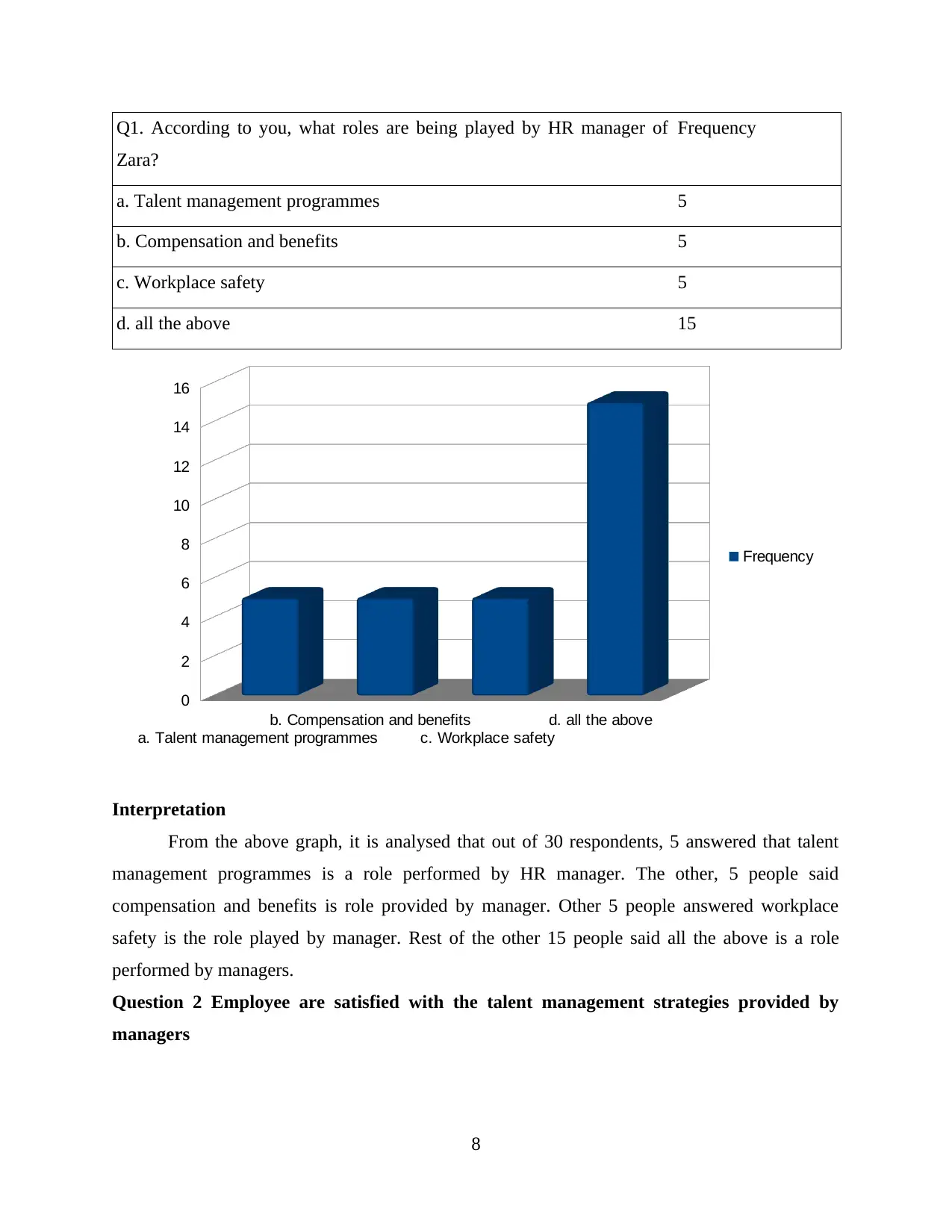
Q1. According to you, what roles are being played by HR manager of
Zara?
Frequency
a. Talent management programmes 5
b. Compensation and benefits 5
c. Workplace safety 5
d. all the above 15
Interpretation
From the above graph, it is analysed that out of 30 respondents, 5 answered that talent
management programmes is a role performed by HR manager. The other, 5 people said
compensation and benefits is role provided by manager. Other 5 people answered workplace
safety is the role played by manager. Rest of the other 15 people said all the above is a role
performed by managers.
Question 2 Employee are satisfied with the talent management strategies provided by
managers
8
a. Talent management programmes
b. Compensation and benefits
c. Workplace safety
d. all the above
0
2
4
6
8
10
12
14
16
Frequency
Zara?
Frequency
a. Talent management programmes 5
b. Compensation and benefits 5
c. Workplace safety 5
d. all the above 15
Interpretation
From the above graph, it is analysed that out of 30 respondents, 5 answered that talent
management programmes is a role performed by HR manager. The other, 5 people said
compensation and benefits is role provided by manager. Other 5 people answered workplace
safety is the role played by manager. Rest of the other 15 people said all the above is a role
performed by managers.
Question 2 Employee are satisfied with the talent management strategies provided by
managers
8
a. Talent management programmes
b. Compensation and benefits
c. Workplace safety
d. all the above
0
2
4
6
8
10
12
14
16
Frequency
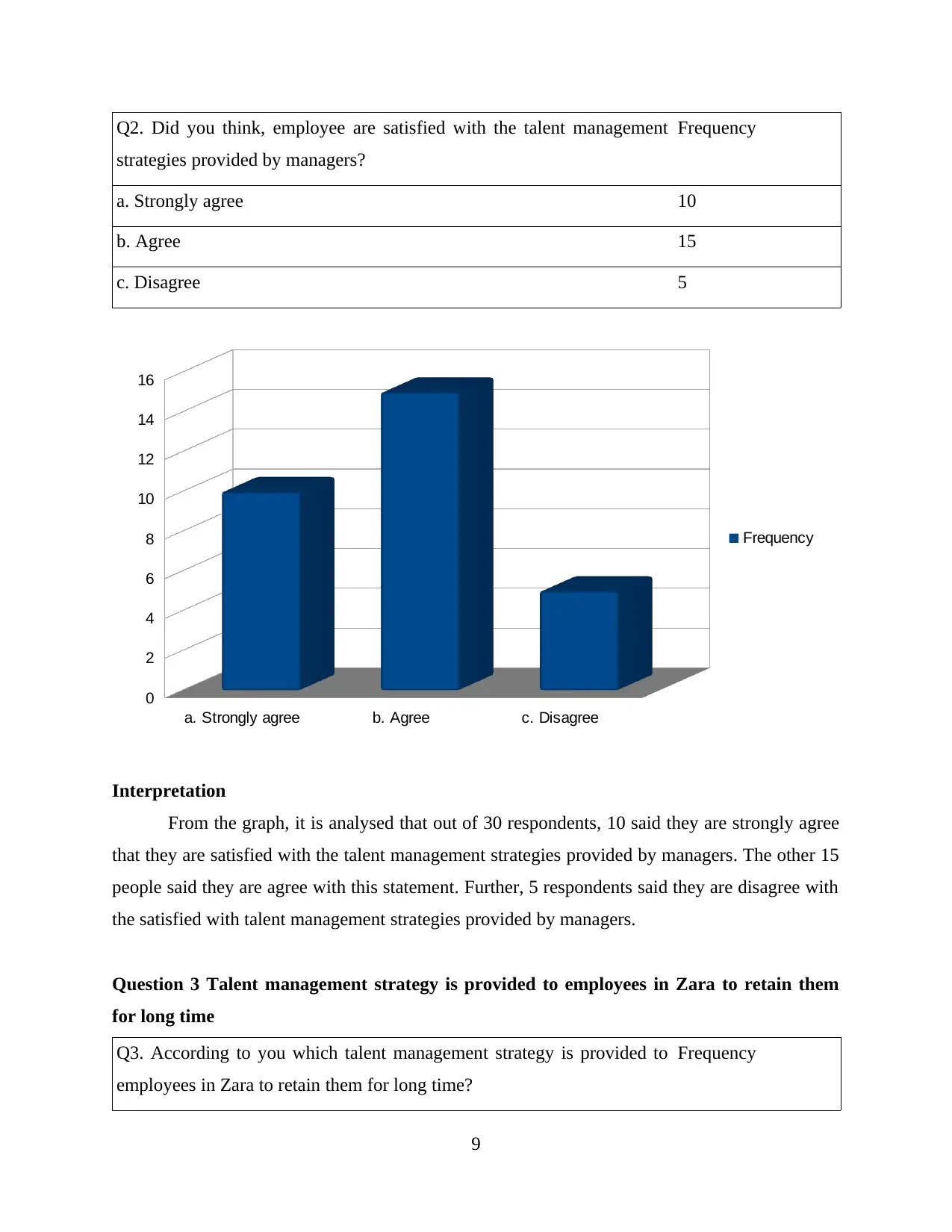
Q2. Did you think, employee are satisfied with the talent management
strategies provided by managers?
Frequency
a. Strongly agree 10
b. Agree 15
c. Disagree 5
Interpretation
From the graph, it is analysed that out of 30 respondents, 10 said they are strongly agree
that they are satisfied with the talent management strategies provided by managers. The other 15
people said they are agree with this statement. Further, 5 respondents said they are disagree with
the satisfied with talent management strategies provided by managers.
Question 3 Talent management strategy is provided to employees in Zara to retain them
for long time
Q3. According to you which talent management strategy is provided to
employees in Zara to retain them for long time?
Frequency
9
a. Strongly agree b. Agree c. Disagree
0
2
4
6
8
10
12
14
16
Frequency
strategies provided by managers?
Frequency
a. Strongly agree 10
b. Agree 15
c. Disagree 5
Interpretation
From the graph, it is analysed that out of 30 respondents, 10 said they are strongly agree
that they are satisfied with the talent management strategies provided by managers. The other 15
people said they are agree with this statement. Further, 5 respondents said they are disagree with
the satisfied with talent management strategies provided by managers.
Question 3 Talent management strategy is provided to employees in Zara to retain them
for long time
Q3. According to you which talent management strategy is provided to
employees in Zara to retain them for long time?
Frequency
9
a. Strongly agree b. Agree c. Disagree
0
2
4
6
8
10
12
14
16
Frequency
⊘ This is a preview!⊘
Do you want full access?
Subscribe today to unlock all pages.

Trusted by 1+ million students worldwide
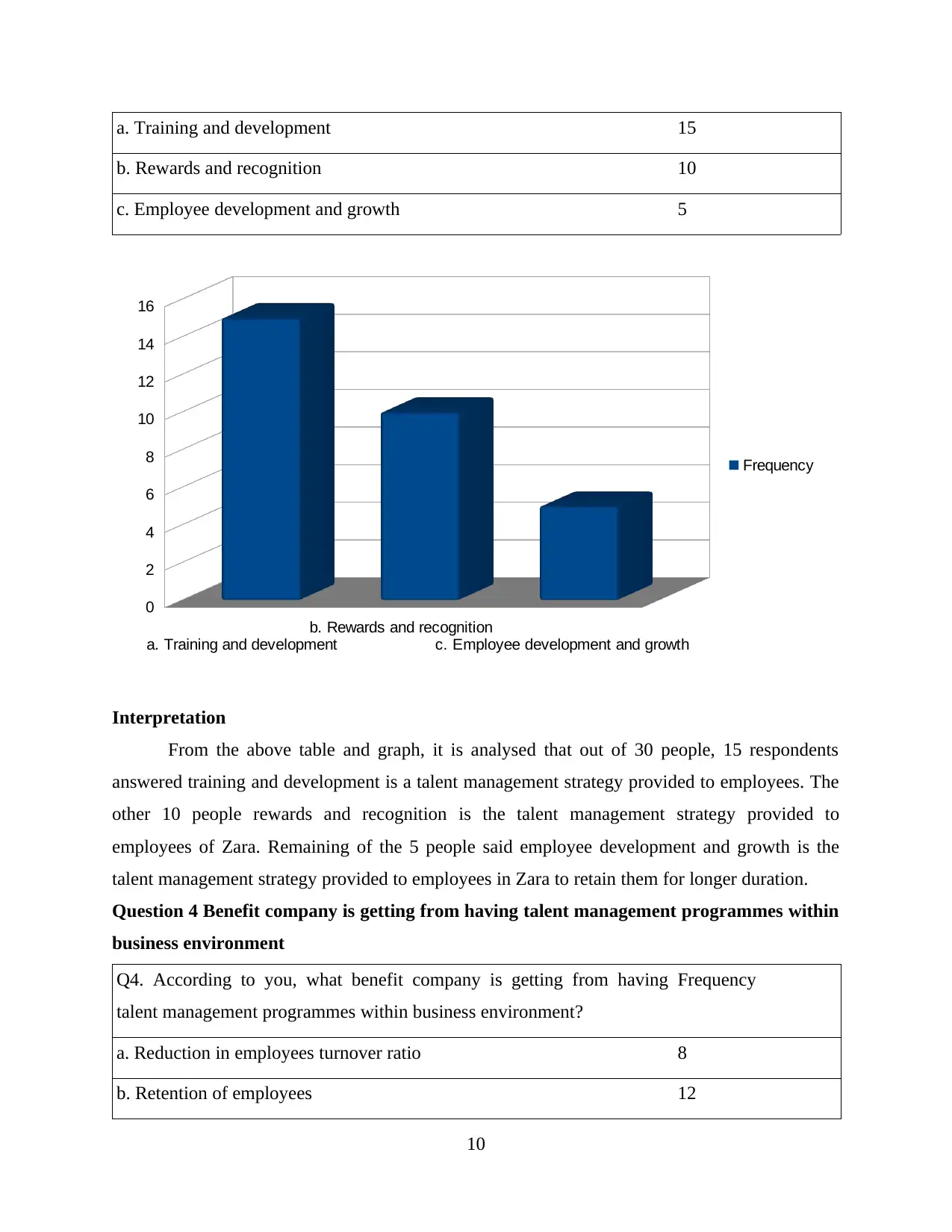
a. Training and development 15
b. Rewards and recognition 10
c. Employee development and growth 5
Interpretation
From the above table and graph, it is analysed that out of 30 people, 15 respondents
answered training and development is a talent management strategy provided to employees. The
other 10 people rewards and recognition is the talent management strategy provided to
employees of Zara. Remaining of the 5 people said employee development and growth is the
talent management strategy provided to employees in Zara to retain them for longer duration.
Question 4 Benefit company is getting from having talent management programmes within
business environment
Q4. According to you, what benefit company is getting from having
talent management programmes within business environment?
Frequency
a. Reduction in employees turnover ratio 8
b. Retention of employees 12
10
a. Training and development
b. Rewards and recognition
c. Employee development and growth
0
2
4
6
8
10
12
14
16
Frequency
b. Rewards and recognition 10
c. Employee development and growth 5
Interpretation
From the above table and graph, it is analysed that out of 30 people, 15 respondents
answered training and development is a talent management strategy provided to employees. The
other 10 people rewards and recognition is the talent management strategy provided to
employees of Zara. Remaining of the 5 people said employee development and growth is the
talent management strategy provided to employees in Zara to retain them for longer duration.
Question 4 Benefit company is getting from having talent management programmes within
business environment
Q4. According to you, what benefit company is getting from having
talent management programmes within business environment?
Frequency
a. Reduction in employees turnover ratio 8
b. Retention of employees 12
10
a. Training and development
b. Rewards and recognition
c. Employee development and growth
0
2
4
6
8
10
12
14
16
Frequency
Paraphrase This Document
Need a fresh take? Get an instant paraphrase of this document with our AI Paraphraser
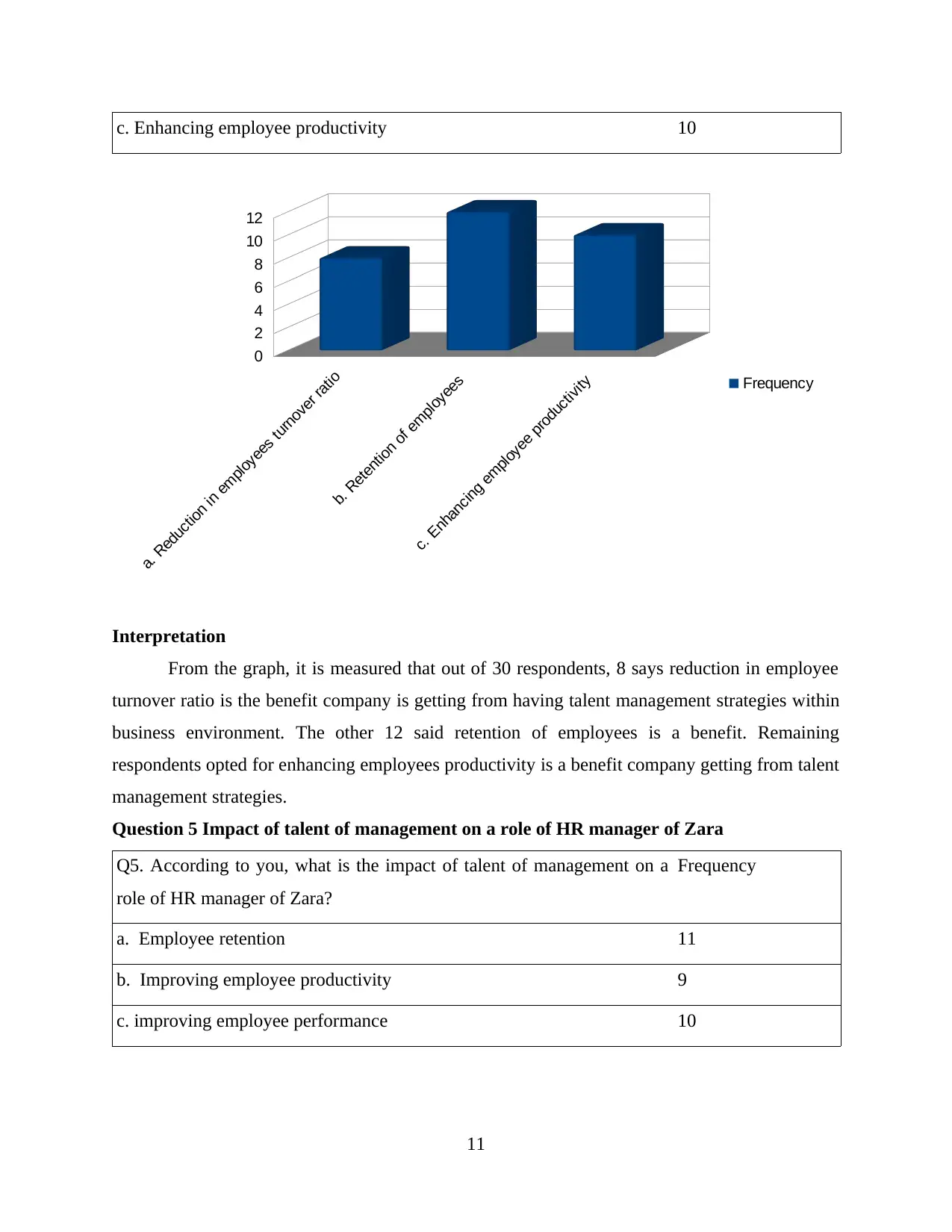
c. Enhancing employee productivity 10
Interpretation
From the graph, it is measured that out of 30 respondents, 8 says reduction in employee
turnover ratio is the benefit company is getting from having talent management strategies within
business environment. The other 12 said retention of employees is a benefit. Remaining
respondents opted for enhancing employees productivity is a benefit company getting from talent
management strategies.
Question 5 Impact of talent of management on a role of HR manager of Zara
Q5. According to you, what is the impact of talent of management on a
role of HR manager of Zara?
Frequency
a. Employee retention 11
b. Improving employee productivity 9
c. improving employee performance 10
11
a. Reduction in employees turnover ratio
b. Retention of employees
c. Enhancing employee productivity
0
2
4
6
8
10
12
Frequency
Interpretation
From the graph, it is measured that out of 30 respondents, 8 says reduction in employee
turnover ratio is the benefit company is getting from having talent management strategies within
business environment. The other 12 said retention of employees is a benefit. Remaining
respondents opted for enhancing employees productivity is a benefit company getting from talent
management strategies.
Question 5 Impact of talent of management on a role of HR manager of Zara
Q5. According to you, what is the impact of talent of management on a
role of HR manager of Zara?
Frequency
a. Employee retention 11
b. Improving employee productivity 9
c. improving employee performance 10
11
a. Reduction in employees turnover ratio
b. Retention of employees
c. Enhancing employee productivity
0
2
4
6
8
10
12
Frequency
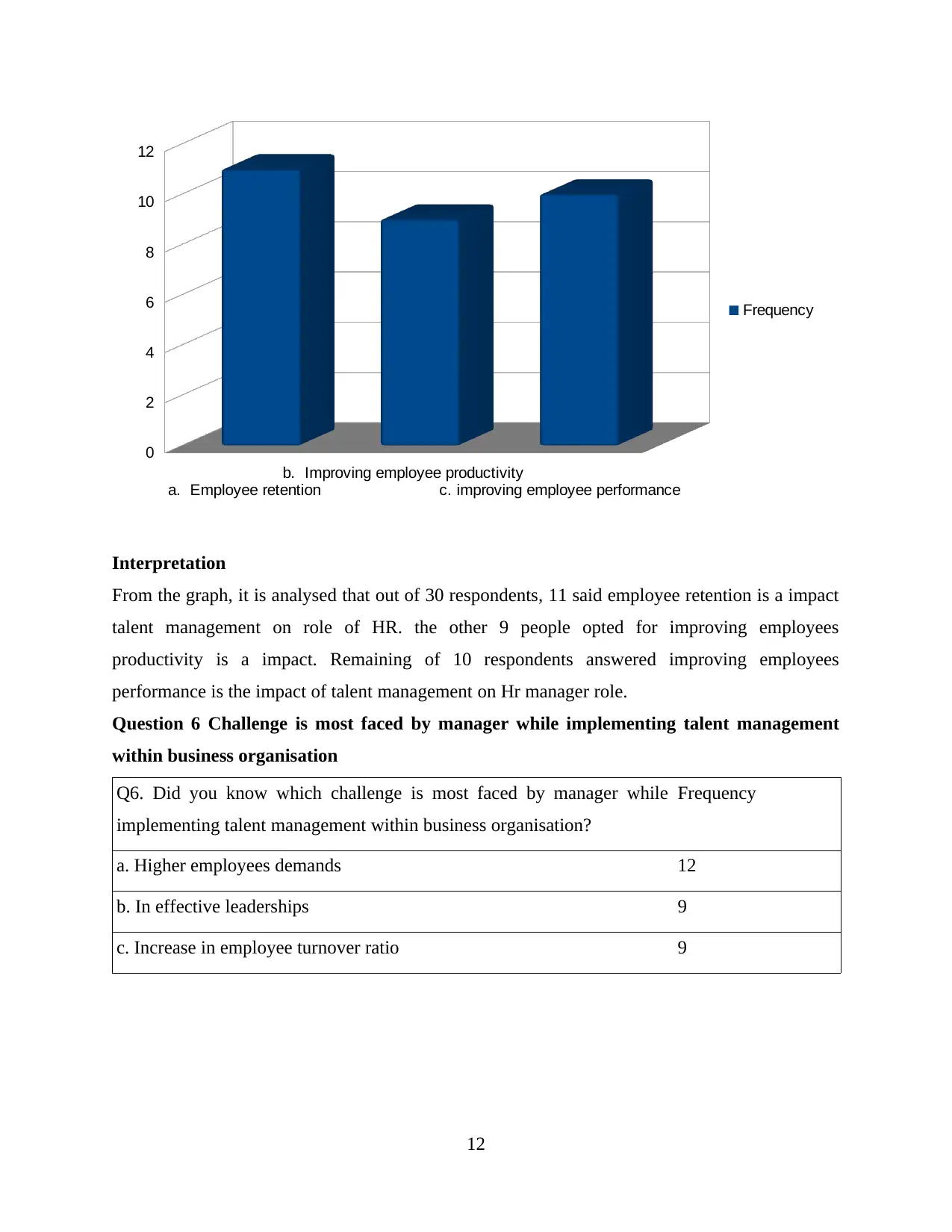
Interpretation
From the graph, it is analysed that out of 30 respondents, 11 said employee retention is a impact
talent management on role of HR. the other 9 people opted for improving employees
productivity is a impact. Remaining of 10 respondents answered improving employees
performance is the impact of talent management on Hr manager role.
Question 6 Challenge is most faced by manager while implementing talent management
within business organisation
Q6. Did you know which challenge is most faced by manager while
implementing talent management within business organisation?
Frequency
a. Higher employees demands 12
b. In effective leaderships 9
c. Increase in employee turnover ratio 9
12
a. Employee retention
b. Improving employee productivity
c. improving employee performance
0
2
4
6
8
10
12
Frequency
From the graph, it is analysed that out of 30 respondents, 11 said employee retention is a impact
talent management on role of HR. the other 9 people opted for improving employees
productivity is a impact. Remaining of 10 respondents answered improving employees
performance is the impact of talent management on Hr manager role.
Question 6 Challenge is most faced by manager while implementing talent management
within business organisation
Q6. Did you know which challenge is most faced by manager while
implementing talent management within business organisation?
Frequency
a. Higher employees demands 12
b. In effective leaderships 9
c. Increase in employee turnover ratio 9
12
a. Employee retention
b. Improving employee productivity
c. improving employee performance
0
2
4
6
8
10
12
Frequency
⊘ This is a preview!⊘
Do you want full access?
Subscribe today to unlock all pages.

Trusted by 1+ million students worldwide
1 out of 22
Related Documents
Your All-in-One AI-Powered Toolkit for Academic Success.
+13062052269
info@desklib.com
Available 24*7 on WhatsApp / Email
![[object Object]](/_next/static/media/star-bottom.7253800d.svg)
Unlock your academic potential
Copyright © 2020–2025 A2Z Services. All Rights Reserved. Developed and managed by ZUCOL.





